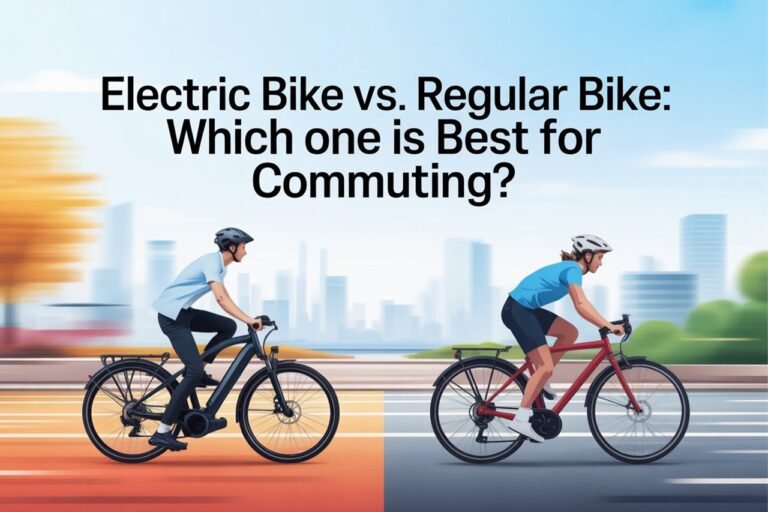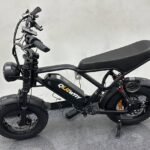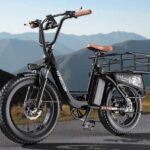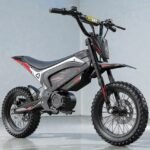
If you’ve ever wondered why some e-bikes feel planted and confidence-inspiring while others chatter, flex, or feel twitchy at speed, the answer is hiding in plain sight: the frame. The ebike frame is the backbone of every electric bicycle—the structure that dictates fit, comfort, handling, durability, battery placement, motor integration, and even which accessories you can run. In short, great electric bike frames don’t just hold parts together; they shape your entire riding experience.
This deep-dive breaks down the anatomy of electric bicycle frames, materials, geometry (yes, those “stack and reach” numbers matter), motor/battery integration, maintenance, and how to pick the right frame for your use case—commuting, cargo hauling, mountain riding, gravel, or folding travel companions. Along the way, you’ll get practical checklists and decision frameworks so you can choose with confidence and keep your frame performing for years.
Why the Frame Matters More on an E-Bike
Conventional bikes live or die by their frame quality, and e-bikes double down on this truth. Motors and batteries add weight and torque. Speed rises. Braking forces go up. Frames must be stiffer where it counts, tougher at stress points, and more thoughtfully engineered to keep you safe and comfortable.
A strong ebike frame:
- Anchors a heavy battery without rattles or creaks
- Manages motor torque (mid-drive or hub) without twisting
- Keeps handling predictable at higher speeds
- Survives bigger braking loads and heavier total system weight
- Offers mounts for racks, fenders, and kickstands that won’t tear out
If you’re comparing two e-bikes with similar motors and batteries, the frame often determines which one you love riding—and which one you avoid.
Anatomy of an Electric Bike Frame
Most electric bike frames mirror the familiar “diamond” layout (top tube, down tube, seat tube, chainstays, seatstays, head tube), but e-bike-specific details set them apart:
- Down Tube & Battery Bay: The down tube is frequently enlarged to house a semi-integrated or fully integrated battery. Good designs use internal cradles and multi-point mounts to eliminate play and reduce noise.
- Motor Mount (Mid-Drive): Instead of a hollow bottom-bracket shell, mid-drive frames use a reinforced motor cradle with thicker material, gussets, and tighter tolerances.
- Dropouts & Torque Management: Hub-motor frames need torque arms or reinforced dropouts to resist axle rotation.
- Cable & Harness Routing: E-bikes add power harnesses, speed sensor wiring, light cables, and sometimes brake-sensor lines. The best frames route these internally with sealed ports to prevent chafe and water ingress.
- Accessory Interfaces: Look for dedicated kickstand plates (often ~40 mm standardized bolt spacing), rack/fender bosses (M5/M6), and bottle bosses placed with battery serviceability in mind.
- Step-Through vs High-Step: Step-through electric bicycle frames replace the top tube with a lower, reinforced structure—easier mounting, especially with bags or child seats. High-step (traditional diamond) frames typically offer higher torsional stiffness.
Frame Materials: Pros, Cons, and What Changes on an E-Bike
Different materials bring distinct personalities to electric bike frames. On e-bikes, these differences are magnified by weight and power.
| Material | What It Feels Like | Strengths | Trade-Offs | Great For |
|---|---|---|---|---|
| Aluminum (6061/7005) | Lively and stiff; efficient power transfer | Affordable, light(ish), corrosion-resistant, easy to mount accessories | Can feel harsh if not well-tuned; weld areas need good QC | Most commuters, folders, many e-MTBs |
| Chromoly Steel (4130) | Supple, smooth, naturally damped | Durable, repairable, fatigue-resistant | Heavier; can rust if neglected | Cargo/utility, touring, classic city bikes |
| Carbon Fiber | Light, precise, can tune stiffness/compliance by zone | Best stiffness-to-weight; design freedom; integrates nicely with batteries | Expensive; needs proper torque/assembly; impact sensitivity | Performance e-road, premium e-MTB, lightweight commuters |
| Titanium (3Al-2.5V) | Magic-carpet smooth yet lively | Corrosion-proof, long-lived, premium feel | Very expensive; fewer mounting options | Enthusiast builds, boutique commuters |
Bottom line: For most riders, aluminum offers the best balance of cost, durability, and accessory support. If you carry heavy loads or want long-tail cargo stability, steel shines. Performance riders chasing lightness may splurge on carbon. Titanium is heirloom-level luxury.
Geometry 101: The Handling You Feel Comes From These Numbers
Geometry is simply how the frame’s tubes relate in space. It dictates posture, comfort, stability, and steering. On e-bikes, where speeds and weights climb, getting geometry right matters even more.
Key terms you’ll see:
- Stack & Reach: Core fit numbers. Stack (vertical height to the head tube top) affects torso angle; reach (horizontal distance) affects cockpit length.
- Head Tube Angle: Slacker (smaller number, e.g., 65–67°) = more stable at speed off-road. Steeper (71–73°) = quicker steering for city/road.
- Seat Tube Angle: Steeper (74–76°) puts you over the cranks—great for climbing and efficient pedaling.
- Chainstay Length: Longer = stability and cargo space; shorter = quick handling.
- Wheelbase: Longer wheelbase = stable; shorter = nimble.
- BB Drop/Height: Influences cornering stability and pedal-strike risk.
Typical ranges by category (not strict rules):
- City/Commuter: Head angle ~70–72°, seat angle ~73–75°, moderate reach/stack for upright comfort, medium chainstays for fenders + racks.
- Cargo/Longtail: Longer chainstays and wheelbase for stability; reinforced rear triangle; upright fit to manage heavy loads.
- E-MTB Trail/All-Mountain: Head angle ~64–66.5°, seat angle ~75–77°, generous reach for control, shortish stems, dropper compatibility.
- Gravel/Fitness: Head angle ~70–72°, seat ~73–75°, balanced reach, room for 40–50 mm tires and mounts.
- Folding: Compact wheelbase, tall stack from long seatposts; look for robust latches and low-flex hinges.
Pro tip: When in doubt, prioritize stack and reach over vague size labels (S/M/L). These two numbers do the best job of comparing bikes across brands.
Step-Through vs High-Step: Which Electric Bicycle Frame Is Better?
Step-through frames (a.k.a. low-step, open frame):
- Pros: Easy mounting in street clothes or with panniers/child seats; friendly for riders with limited mobility; great for stop-and-go urban riding.
- Trade-offs: Slightly less torsional stiffness (modern designs compensate with oversized down tubes and internal ribs); fewer triangle spaces for large frame bags.
High-step (traditional diamond):
- Pros: Excellent stiffness-to-weight; classic look; more top-tube accessory room.
- Trade-offs: Swinging a leg over cargo or a high saddle can be awkward for some riders.
Verdict: For city and cargo usage, step-through ebike frames are often the best choice for practicality. For off-road and aggressive riding, high-step tends to feel tighter and more precise.
Motor & Battery Integration: Why It Changes the Frame Game
Where you put a motor and battery radically changes how a ebike frame must be built.
Mid-Drive Frames
- Motor at the bottom bracket keeps mass centered and low—great handling on trails and in city traffic.
- Requires reinforced motor cradle and down-tube junctions.
- Allows standard rear wheels (easier spoke service, wider gearing choices).
- Often pairs with internal battery in the down tube (clean look, weather protection).
Hub-Motor Frames
- Rear hub adds unsprung weight and torsional loads to dropouts. The frame should have reinforced or specially designed torque interfaces so the axle can’t spin.
- Battery mounting becomes even more critical for balance—central and low is ideal.
- Simpler drivetrain (no mid-drive wear on cassettes/chains), often lower cost.
Batteries: Internal vs External
- Internal (integrated): Cleaner look, weather-sealed, theft-resistant; check ease of removal for service and whether you can lock it.
- External (bolt-on): Easier to swap and upgrade; slightly more exposed; usually adds weight higher on the frame unless cradled low.
What to look for: multi-point battery mounts, metal reinforcement plates (not just plastic cradles), and rattle-free fit. A quiet frame is usually a well-engineered one.
Frame Category Deep-Dive (Choose by Use Case)
1) City & Commuter E-Bikes
- Best frame style: Step-through aluminum with integrated battery.
- Geometry: Neutral, upright posture for visibility; room for full fenders and 40–50 mm tires.
- Essential mounts: Rear rack, kickstand plate, front light mount that doesn’t twist the fork crown.
- Why it works: Confidence at low speed, easy dismounts at traffic lights, and practical accessory support.
2) Cargo & Utility (Longtail, Midtail, Front-Loader)
- Best frame material: Chromoly steel or heavily gusseted aluminum.
- Geometry: Long chainstays/wheelbase for stability; robust rear triangles with multiple rack mounts.
- Pay attention to: Maximum system weight rating, child-seat compatibility, and 2-leg center stands.
- Why it works: Strong rear end and slow-steer stability make heavy loads feel manageable.
3) E-MTB (Hardtail & Full Suspension)
- Hardtail: Stiff aluminum or carbon main triangle with modern trail geometry; lower maintenance, lighter, great for mixed terrain.
- Full-Suspension: Dedicated shock mounts and kinematics tuned for e-MTB weight; look for motor-optimized anti-squat and room for a bottle cage.
- Why it works: Aggressive geometry + central mass = confident descending and technical climbing.
4) Gravel & Adventure
- Best frame style: Aluminum or carbon with big tire clearance, top-tube bag mounts, and multiple bottle positions around the battery bay.
- Geometry: Stable but not sluggish; head ~70–72°, seat ~73–75°.
- Why it works: Blends road speed with light off-road comfort, perfect for long mixed-surface days.
5) Folding & Travel
- Best frame style: Reinforced hinge design with stout latch hardware; aluminum to keep weight reasonable.
- Must-haves: Secondary safety catch on the hinge, adjustable steering column with anti-twist interface, and a solid rear triangle with rack/fender options.
- Why it works: Compact storage without sacrificing safety or stiffness.
Fit & Sizing: How to Nail the Right Ebike Frame
1) Start with Stack & Reach:
These coordinates define how stretched and how tall your cockpit will be. If you’re between sizes, a shorter reach and higher stack creates a more upright ride; longer/lower feels sportier.
2) Standover Height:
Step-through frames minimize this concern. On high-step frames, aim for 2–5 cm of clearance in regular shoes.
3) Rider Height vs Frame Size (very general starting points):
- 5’2″–5’6″ (157–168 cm): XS–S
- 5’6″–5’10” (168–178 cm): S–M
- 5’10″–6’2″ (178–188 cm): M–L
- 6’2″+ (188 cm+): L–XL
Always check the brand’s chart; electric bicycle frames vary widely due to battery bay and motor packaging.
4) Contact Points & Adjustability:
- Stem length: 40–80 mm on many modern e-bikes; shorter stems add confidence at speed.
- Handlebar rise/sweep: More rise and back-sweep = more upright comfort.
- Seatpost: Consider a dropper post for stop-and-go city riding and e-MTB control (ensure internal routing support).
Accessory Compatibility: Mounts Make the Difference
Before you buy, inventory the mounts on the ebike frame:
- Rear rack mounts at the dropouts and seatstays (prefer M6 threads for heavy loads).
- Kickstand plate behind the bottom bracket (check 2-bolt 40 mm interface).
- Fender mounts at fork crown, seatstay bridge, and dropout eyelets.
- Bottle bosses that remain usable with the battery in place.
- Front accessory mounts (some frames or head tubes accept racks or cargo plates).
- Thru-axle vs quick-release: e-MTBs commonly use 12×148 mm Boost rear; many commuter hub-motor frames still use 135 mm QR—ensure your wheel and motor choice matches.
If you plan to carry kids or run a heavy pannier setup, prioritize frames with published system weight limits and tested rack interfaces—not all frames are rated for the same loads.
Safety, Testing, and What Certifications Mean
Reputable electric bike frames are tested to standard bicycle fatigue and impact tests, and complete e-bike systems often undergo electrical safety certification.
- ISO 4210 (bicycle safety) covers frame/fork fatigue and impact tests—good for general structural assurance.
- EN 15194 (EPACs in EU) addresses safety requirements for e-bikes, including mechanical and electrical components.
- UL 2849 (North America, e-bike systems) focuses on electrical safety (battery/charger/system), not frame-only, but it’s a strong indicator that the whole platform is thoughtfully engineered.
What to do as a buyer:
Prefer brands that publicly reference testing standards and provide clear weight limits (rider + cargo + bike). If you’re shopping cargo or e-MTB, this matters even more.
Maintenance: Make Your Frame Last
A quality ebike frame should last many years with simple care:
- Bolt Torque & Annual Check
- Motor mount bolts, rack/kickstand plates, and bottle bosses can loosen over time. Use a torque wrench to manufacturer specs.
- Inspect Stress Zones
- Look for hairline cracks or paint lines around the head-tube/downtube junction, seat-tube/top-tube junction, motor cradle, and rack mounts.
- Clean, Don’t Pressure-Blast
- Avoid high-pressure water near bearings, harness ports, battery seals, and hinge latches (folding frames).
- Protect Bare Metal
- On steel frames, treat chips promptly to stop rust. On aluminum, oxidation is cosmetic but still keep it clean.
- Carbon Assembly Paste
- If you have carbon components clamped to the frame (e.g., seatpost in an alloy frame), use carbon paste and proper torque to prevent slipping and crushing.
- Hinge Care (Folders)
- Latch alignment and lubrication are critical; any play here becomes creaks and, eventually, cracks.
- Battery Bay Hygiene
- Keep contacts dry and clean; check rubber gaskets and drain holes; ensure the locking mechanism stays snug.
Common Myths About Electric Bicycle Frames
- “Carbon is too fragile for e-bikes.”
Quality carbon frames are engineered for e-bike loads. Impacts damage any material; the key is good design and proper use. - “Step-through frames are weak.”
Modern step-through designs use oversized tubes, internal ribs, and gussets. For city and cargo work, they’re often more practical and plenty strong. - “Any old frame can be converted.”
Conversions add torque and weight a non-e-bike frame may not be designed to handle—especially at dropouts. If converting, choose frames known to tolerate e-loads and use proper torque arms and hardware. - “Geometry is just marketing.”
Your comfort, safety, and handling live or die by geometry. Two frames with the same motor can ride completely differently.
The Decisive Buy: Choose the Best Ebike Frame for Your Riding
If you want one-line recommendations you can act on today, here they are:
- Urban commuting with bags → Step-through aluminum frame with integrated down-tube battery, neutral geometry, full fender/rack mounts, kickstand plate.
- Hauling kids/groceries → Steel longtail cargo frame (or heavy-duty aluminum) with published high system weight, double-leg center stand, reinforced rack interface.
- Trail riding & mixed terrain → Modern e-MTB aluminum frame if you’re value-minded; carbon if you want lighter and stiffer with refined ride feel.
- Travel & multi-modal → Reinforced aluminum folder with robust hinge, secondary safety latch, and low-mounted battery.
- Gravel & fitness → Aluminum gravel frame with big tire clearance, extra mounts, neutral-stable geometry.
Pick your category, then evaluate fit (stack/reach), battery/motor integration, and mounts. Those three choices determine 90% of your day-to-day satisfaction.
Future Trends in Electric Bike Frames
- Deeper Integration: Hidden batteries that still remove easily; internal routing for lights and radar; stealthy wiring looms.
- Modular Mount Ecosystems: Standardized bosses that accept front cargo plates, child seats, and quick-swap batteries without adapters.
- Advanced Alloys & Layups: Aluminum hydroforming and carbon layup strategies that selectively add stiffness (motor cradle) while preserving comfort (seatstays).
- Universal Hanger/Interface Standards: More frames adopting robust, replaceable interfaces that simplify parts compatibility and wheel swaps.
- Printed Lugs & Custom Geometry: Small-batch builders use 3D-printed lugs to deliver custom-fit electric bicycle frames without exotic price tags.
Quick Checklist Before You Buy
- Use Case Clarity: Commute, cargo, trail, gravel, folding?
- Fit Numbers: Stack/reach within your comfort zone; check standover on high-step.
- Battery & Motor: Central, low placement; secure multi-point mounts; easy service/removal.
- Mounts & Interfaces: Rack, fender, kickstand, bottle, child-seat, front cargo compatibility.
- Wheel & Axle Standards: Ensure hub/motor/wheel matches the frame spec (135 QR vs 12×148, etc.).
- Weight Limits & Testing: Clear system weight rating; references to ISO/EN testing; ideally UL-listed electrical system on the complete bike.
- After-Sales Support: Replaceable hardware (hinges, plates, covers), battery doors, and rubber gaskets readily available.
Frequently Asked Questions About Electric Bike Frames
Q1: Are ebike frames different from regular bike frames?
Yes. Ebike frames are reinforced to handle motor torque, battery weight, and higher braking forces. They often include a motor cradle, battery bay, internal harness channels, and stronger mounting points.
Q2: Step-through or high-step—what’s better?
For urban utility, step-through offers easier mounting and dismounting—especially with panniers or a child seat. For aggressive or technical riding, high-step frames typically feel stiffer and more precise. Choose based on your terrain and mobility.
Q3: Which frame material should I choose?
Aluminum is the best overall value for most riders. Steel is king for heavy cargo and long-term durability. Carbon is for performance and weight savings (at a price). Titanium is premium and timeless.
Q4: Can I convert any frame into an e-bike?
You can, but not all frames are suitable. Hub-motor conversions need robust dropouts and torque management. Battery placement and wiring are also key. If you’re converting, start with a strong, modern frame and use proper hardware.
Q5: How long should an ebike frame last?
With normal use and maintenance, many years. Periodically inspect stress zones, keep bolts torqued, and avoid pressure-washing bearings and battery ports.
Q6: What size electric bicycle frame should I ride?
Use the brand’s size chart, but validate with stack/reach. If you want upright comfort, prioritize higher stack and shorter reach. If you want sporty handling, go lower/longer.
Q7: Are carbon electric bike frames safe?
High-quality carbon frames engineered for e-bike loads are safe when assembled correctly. Use a torque wrench, carbon paste where needed, and follow the manufacturer’s guidelines.
Q8: What accessories require special frame support?
Child seats, heavy panniers, front cargo platforms, and double-leg center stands. Make sure your frame has reinforced mounts and a published system weight rating.
Putting It All Together
A great ebike frame translates motor power into real-world confidence. It fits your body, stabilizes the battery, tames torque, and holds your cargo without flinching. Choose the frame by use case first, confirm fit with stack/reach, verify battery/motor integration, and double-check mounts and weight limits. Do that, and you’ll end up with an e-bike that feels like it was built just for you.
Whether you gravitate toward a sleek, integrated urban step-through, a steel longtail that swallows weekly grocery runs, a carbon e-MTB ready to devour singletrack, or a clever folder that pops into the trunk—remember: everything great about your e-bike starts with the frame. And the best electric bike frames make every ride smoother, safer, and a lot more fun.


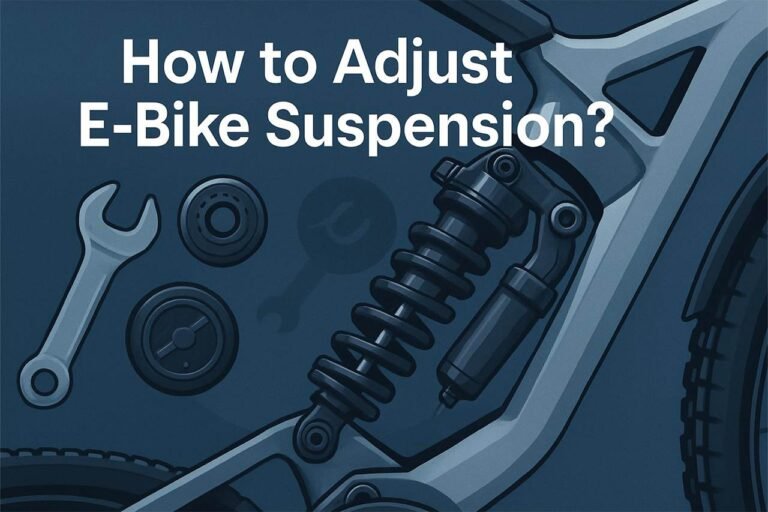
![How to Change Gears on a Bike: A Beginner’s Step-by-Step Guide [year] How to Change Gears on a Bike: A Beginner’s Step-by-Step Guide [year]](https://goebikelife.com/wp-content/uploads/2023/12/How-to-Change-Gears-on-a-Bike-for-Beginners-768x512.jpg)
